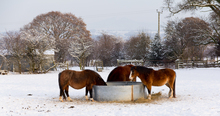In many areas, winter pastures should not be relied upon to provide the sole source of nutrients for horses since they are usually poor feed sources for many horses. Not only is the nutrient quality poor but, in deep snow, the maintenance energy needs of horses can increase by 40% because the horses have to crater or paw through the snow to find low quality feed.

Meeting cold weather nutritional needs of horses
The extra cost of feed needed to rehabilitate a thin horse back to normal will equal or exceed the cost of the feed that should have been given to the horse to maintain its body weight - feeding horses is costly; not feeding horses is more costly.
The cost of weight loss in the horse is much higher than most people realize. Thin, malnourished stallions lose their ability to produce sperm. Thin mares have a very low conception rate. Underfed weanlings can become permanently stunted.
Finally, the extra cost of feed needed to rehabilitate a thin horse back to normal will equal or exceed the cost of the feed that should have been given to the horse to maintain its body weight. Feeding horses is costly; not feeding horses is more costly.
Guidelines for Feeding Horses During Cold Weather
- The easiest method of feeding horses in cold weather is the simplest: feed high quality forages free-choice. Most horses will eat 2 to 2.5% of their body weight in hay per day. Average daily free-choice intakes of hay by a 600 kg (1320 lb) horse is 12 – 15 kg (26 – 33 lbs)/day or about a half of a 65-lb square bale per horse per day.
- Use highly digestible hays and supply a sufficient quantity of hay. Coarse over mature hays are low in energy and high in indigestible fibre. In cold weather, when energy demands are high, over mature hays will not supply sufficient energy and, furthermore, if fed without sufficient water, can cause impactions.
- Alternatively, grain can be added to the diet. Caution must be used when adding grain to the diets of horses unaccustomed to grain because founder (laminitis) can occur. All horses fed grain should be gradually adapted to small amounts of grain over a period of 7-10 days.
- Supplemental vitamins A, D and E may be needed. Appropriate mineral-vitamin mixes should be chosen. A fortified 2:1 calcium-phosphorus mixture is recommended for feeding with grass hays and a 1:1 Ca-P mixture is recommended for feeding with alfalfa hay.
- Provide adequate heated (2-10°C) water, if possible. Water helps maintain appetite and digestive function. Snow is not a suitable substitute.
- If available, a well-bedded, south or east-facing shed is useful for young and old horses. Alternatively, provide protection from the wind by providing bedding areas behind snow fences, in coulees or bluffs, or among trees. Horses that can lie down will conserve body heat.
Information from Ontario Ministry of Agriculture: Dr. Nadia Cymbaluk/Carberry Manitoba, accessed on 11/21/2013.
